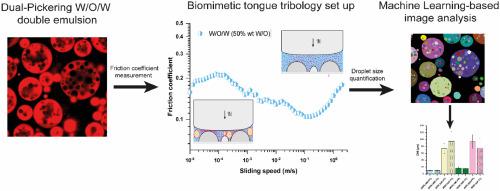Tribology of dual Pickering double emulsions: Machine learning-aided inner droplet analysis
IF 11
1区 农林科学
Q1 CHEMISTRY, APPLIED
引用次数: 0
Abstract
This study investigated the tribological performance of Pickering water-in-oil emulsions and dual Pickering water-in-oil-in-water double emulsions (DEs) stabilized with particles at both the interfaces. W/O emulsions were stabilized by cocoa butter-based oleogel (CBolg) crystals, while DEs incorporating these emulsions were stabilized by whey protein microgels (WPM). The influence of temperature (21 and 37 °C) and surface texture (smooth vs biomimetic tongue-like surface) were investigated in tribology of W/O emulsions (30–60 % v/v water) and DEs (with 20 and 60 wt% W/O phase). In smooth surfaces, CBolg played a critical role in reducing the friction coefficient (μ) primarily via a fat-driven lubrication mechanism that was temperature dependent. While in DEs, smaller oil droplets encapsulating water provided similar lubrication to oil-based systems until starvation occurred. Strikingly, the water content in W/O emulsions exhibited distinct differences between emulsion systems within the biomimetic tongue-like surfaces, demonstrating lower lubricity at higher water concentration. Confocal microscopy images analyzed using Machine Learning (ML)-supported droplet segmentation enabled a more precise evaluation of structural changes within DEs when subjected to tribological stress. We demonstrated that although changes in inner droplet size altered in DEs, their contribution to the overall lubrication performance was minimal, due to their limited entrainment. Of more importance, the tribological performance was governed by the WPM with minimal influence from the droplet-entrained phenomena. These fundamental insights highlight the relevance of structured water in understanding frictional performance in emulsified systems, with structural integrity, composition, and topography of the tribological surface emerging as key factors.

双皮克林双乳的摩擦学:机器学习辅助的内液滴分析
研究了皮克林油包水乳状液和双皮克林油包水双乳状液的摩擦学性能。W/O乳剂由可可脂基油凝胶(chbolg)晶体稳定,而含有这些乳剂的de则由乳清蛋白微凝胶(WPM)稳定。研究了温度(21°C和37°C)和表面纹理(光滑与仿生舌状表面)对W/O乳剂(30 - 60% v/v水)和DEs(20和60 wt% W/O相)摩擦学的影响。在光滑表面,chbolg主要通过脂肪驱动的润滑机制(与温度相关)在降低摩擦系数(μ)方面发挥了关键作用。而在DEs中,较小的油滴包裹水,提供与油基系统类似的润滑,直到发生饥饿。引人注目的是,在仿生舌状表面的乳液体系中,水/油乳液的含水量表现出明显的差异,在高水浓度下表现出较低的润滑性。使用机器学习(ML)支持的液滴分割分析共聚焦显微镜图像,可以更精确地评估DEs在受到摩擦应力时的结构变化。我们证明,尽管内部液滴尺寸的变化改变了DEs,但由于它们的有限夹带,它们对整体润滑性能的贡献是最小的。更重要的是,WPM的摩擦学性能受液滴夹带现象的影响最小。这些基本见解强调了结构水在理解乳化体系摩擦性能方面的相关性,其中结构完整性、组成和摩擦学表面的形貌成为关键因素。
本文章由计算机程序翻译,如有差异,请以英文原文为准。
求助全文
约1分钟内获得全文
求助全文
来源期刊

Food Hydrocolloids
工程技术-食品科技
CiteScore
19.90
自引率
14.00%
发文量
871
审稿时长
37 days
期刊介绍:
Food Hydrocolloids publishes original and innovative research focused on the characterization, functional properties, and applications of hydrocolloid materials used in food products. These hydrocolloids, defined as polysaccharides and proteins of commercial importance, are added to control aspects such as texture, stability, rheology, and sensory properties. The research's primary emphasis should be on the hydrocolloids themselves, with thorough descriptions of their source, nature, and physicochemical characteristics. Manuscripts are expected to clearly outline specific aims and objectives, include a fundamental discussion of research findings at the molecular level, and address the significance of the results. Studies on hydrocolloids in complex formulations should concentrate on their overall properties and mechanisms of action, while simple formulation development studies may not be considered for publication.
The main areas of interest are:
-Chemical and physicochemical characterisation
Thermal properties including glass transitions and conformational changes-
Rheological properties including viscosity, viscoelastic properties and gelation behaviour-
The influence on organoleptic properties-
Interfacial properties including stabilisation of dispersions, emulsions and foams-
Film forming properties with application to edible films and active packaging-
Encapsulation and controlled release of active compounds-
The influence on health including their role as dietary fibre-
Manipulation of hydrocolloid structure and functionality through chemical, biochemical and physical processes-
New hydrocolloids and hydrocolloid sources of commercial potential.
The Journal also publishes Review articles that provide an overview of the latest developments in topics of specific interest to researchers in this field of activity.
 求助内容:
求助内容: 应助结果提醒方式:
应助结果提醒方式:


